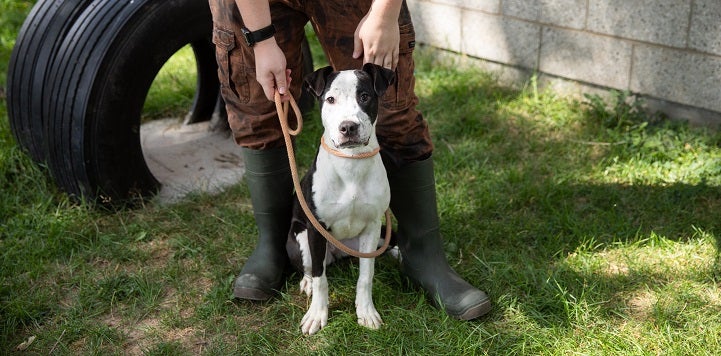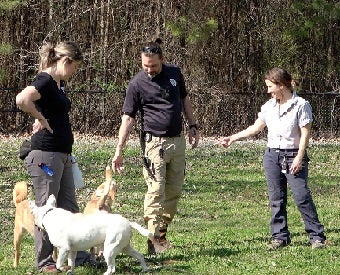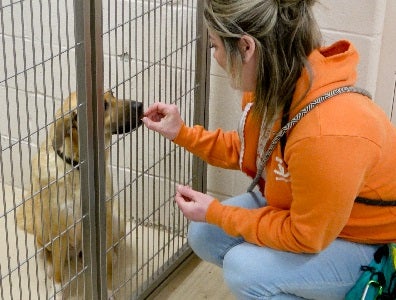
New videos increase access to dog handling training by Best Friends experts
June 28, 2023
If Best Friends National Shelter Support Specialist Tierney Sain could clone herself, she’d probably jump at the opportunity. After all, it would mean more shelters could benefit from in-person training on dog handling. But Tierney is just one person, and she can only visit a fraction of the shelters needing help. So, to use her talents and give more organizations the chance to benefit from her knowledge, she came up with another strategy: filming a series of videos about the most common challenges managing dogs in shelters.
“I find that having a visual resource is especially important with handling,” she says. “That's how I learn best, and I have noticed during shelter visits that seeing is believing. You can explain things, but it doesn't always resonate. If the person can see you demonstrate what you're talking about, it changes the whole game.”
The dog handling toolkit features 14 videos on a variety of common topics and were filmed at Pine Bluff Animal Control, where Best Friends currently has an embed project. They range from 40 seconds long to just under five minutes, so they are not time-consuming for staff to review.
“Because these tools are in a format that can be referred back to at any time, shelters that need help can use them to improve the shelter experience for everyone,” says Cathy Overfield, manager of operations for embed projects. “Having these videos filmed at Pine Bluff allowed the staff to do some hands-on learning, and that’s always helpful. But even those people who were familiar with the information appreciated having a refresher and hearing new ideas from Tierney.”
Video topics: Touching on the “top three”
When deciding on topics for the videos, Tierney knew she definitely needed to focus on those that are challenging for practically every shelter: barrier reactivity/frustration, jumpy/mouthy behavior, and shy/fearful behavior. Such behaviors are easy to misinterpret, and commonly lead to dogs being labeled unadoptable.
 “When dogs communicate using body language and vocalizations that have come to be frequently associated with aggression, they can be considered risky to place in homes,” Tierney says. “This is most common with frightened or overwhelmed dogs. Especially when assessments take place during initial handling by field officers or when a dog first arrives at the shelter, that’s not a true picture of their personality.”
“When dogs communicate using body language and vocalizations that have come to be frequently associated with aggression, they can be considered risky to place in homes,” Tierney says. “This is most common with frightened or overwhelmed dogs. Especially when assessments take place during initial handling by field officers or when a dog first arrives at the shelter, that’s not a true picture of their personality.”
A lack of knowledge is one reason why staff might consider a dog a safety risk, but inadequate training can just as readily lead to such a decision.
“It’s important that staff understand why a dog is behaving a certain way so they can determine how to manage it,” she says. “We want dogs to have a positive outcome and leave the shelter as soon as possible, so we need to invest time to build relationships with them.”
Getting to know dogs as individuals is key to designing a behavior program that will help them progress and allows more appropriate adoption matches. Shy dogs who are very dog-friendly greatly benefit from time spent in a play yard with other canines who are comfortable around people. Since shy dogs can be difficult to handle, however, staff need to explore ways to help them enter and exit their kennels without overwhelming them.
“We need to weigh the pros and cons of choices like insisting dogs with poor leash skills walk on one too soon,” Tierney says. “If the dog is small enough, we can transport them in a crate; we can also help them get more comfortable around us and build trust by doing quiet activities like reading to them. And we always need to be aware of how we use our body language to interact with shy or frightened dogs and avoid being loud or move too fast, which can set back their progress.”
Tierney also notes that we need to reconsider the language we use in animal welfare. That especially applies to blanket terms like “aggressive.”
“We need to really look at the terminology we use when we're talking to each other as well as when we talk to potential adopters,” she says. “When a staff member says, ‘This dog is really jumpy/mouthy and can't go home with kids,’ that’s not fair to a rambunctious younger dog who just needs some basic training. The public doesn’t know how to interpret that information other than to walk away and look at other dogs.”
Video topics: Covering other common issues
Every dog can benefit from enrichment, as it enhances their quality of life, helps them manage stress, reduces risk of disease, and cuts down on length of stay. It doesn’t have to take a lot of one-on-one staff time either or involve buying expensive items.
 “Literally anything is enrichment; you make it out of nothing,” Tierney says. “There's so much more that you can do that's fun for the dogs. Kongs stuffed with peanut butter or other treats are great, but you can create food puzzles using water bottles or make popsicles with some of their food. Adding things into the daily routine avoids overloading an already busy staff.
“Literally anything is enrichment; you make it out of nothing,” Tierney says. “There's so much more that you can do that's fun for the dogs. Kongs stuffed with peanut butter or other treats are great, but you can create food puzzles using water bottles or make popsicles with some of their food. Adding things into the daily routine avoids overloading an already busy staff.
“You can also leave a radio on or spritz essential oil on their blankets,” she adds. “For more destructive dogs, put the oils on a rag that hangs somewhere out of reach. Nose work is always great, too. Hide something they really like in a box to reward them. Quiet time is beneficial for any dog, because it gives them a break from all the people walking by their kennels and allows them to decompress.”
Tierney also created videos on setting up feeding routines, using a clicker to train dogs, safely running playgroups, and handling tips for medical procedures. No matter the topic, however, each video is designed to provide a baseline of skills that can be adjusted to suit the needs of individual organizations.
“I'm hoping the videos can serve as training tools for shelter staff or volunteers,” she says. “They don’t have to be new to the organization, either. This information is even helpful for those who have been in the shelter world for a while. After all, even old dogs can always learn new tricks.”
Resources
- Dog behavior and handling webinar
- Dog reactivity webinar
- “Got behavior-challenged dogs?” program spotlight
- Dealing with leash reactivity
- “Why We Don’t (or Rarely) Use Punishment”
- “Virtual dog training w/Goodpup” podcast
- “Canine care and enrichment” playbook

Liz Finch
Senior Writer
Best Friends Network
If you enjoyed this program spotlight, you can find our complete catalog of spotlights here.